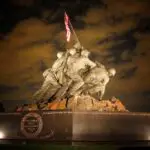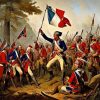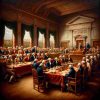The New Deal: A Beacon of Hope in America’s Darkest Hour during an Incredible Era. Herein, we will delve deeply into it so even 3rd graders and those with limited English proficiency can understand its significance—breaking down its core components, profiling critical figures involved, and exploring its lasting legacy on United States society.
Understanding the New Deal:
The New Deal emerged during one of America’s most trying eras, the Great Depression, in the 1930s. Many lost jobs, homes, savings, and wastage; as this crisis took shape, President Franklin D. Roosevelt introduced his plan of revitalizing both the economy and spirit. The New Deal (a comprehensive plan with multiple strategies intended to revive America) was introduced during this challenging period.
Critical Components of the New Deal:
- Social Structure: The New Deal was marked by an array of programs aimed at addressing various facets of the economic crisis. Among these, the Civilian Conservation Corps (CCC) was established to provide jobs in natural resource conservation, offering work to hundreds of thousands of young men and thus revitalizing both the workforce and the environment.
- Similarly, the Agricultural Adjustment Act (AAA) sought to stabilize agricultural prices and support farmers by reducing crop production, thereby increasing prices and making farming more viable.
- Additionally, the Works Progress Administration (WPA) played a crucial role in job creation, not only in construction and infrastructure but also in supporting the arts, thus employing a diverse range of skills across the nation. These programs, among others, were central to the New Deal’s strategy to rejuvenate the economy and provide relief to those affected by the Great Depression.
- Social Security: Social Security, a pivotal element of the New Deal, established a foundational safety net for Americans. Enacted in 1935, this program was designed to provide financial assistance to the elderly, the disabled, and the unemployed, marking a significant shift in the government’s role in individual welfare. By requiring contributions from workers and employers during their employment years, Social Security ensured that individuals would receive benefits upon retirement or in the event of disability, thus offering economic security and stability to millions of Americans. This groundbreaking initiative alleviated immediate hardships and laid the groundwork for future social welfare policies.
Notable Figures in the History of the New Deal:
- Many vital individuals were responsible for making Franklin D. Roosevelt’s New Deal an exciting reality, including President Franklin D. Roosevelt, who pioneered it all from its conception through implementation. As president, he tirelessly championed its various programs.
- As First Lady, Eleanor Roosevelt also played an indispensable part in her husband’s presidency. She embarked on journeys across the country, engaging with ordinary citizens while directly relaying their needs and concerns to him, as her husband was president.
- Frances Perkins made history when she became the first woman ever appointed as one of President Roosevelt’s cabinet members. She played an essential part in helping shape many New Deal programs aimed at aiding workers, including programs designed for worker assistance.
Implications of the New Deal:
- The New Deal had an enormous and lasting effect on American society. Serving as an anchor during the Great Depression, its programs offered hope and relief for millions. Creating jobs, providing financial aid to needy households, and guaranteeing the integrity of the banking system aided America in rebuilding itself from this period.
- Furthermore, the New Deal altered how the government played an instrumental role in citizens’ lives. Before, the government rarely intervened to help alleviate economic challenges or assist with times of hardship. Still, thanks to this landmark initiative, governments were shown that they can play an integral role in assisting during times of distress.
- Social Security continues to provide financial protection to retirees and people with disabilities; its emphasis on infrastructure development and job creation laid a solid foundation for modern American society, leaving an indelible mark on the economy and public works projects today.
The Ongoing Relevance of the New Deal:
- The impact of the New Deal extends far beyond history books; its legacy can still be felt today in American society. Social Security provides critical financial assistance for millions of retirees and people with disabilities, ensuring peace and dignity during later life.
- Infrastructure development remains one of the cornerstones of New Deal policies today; roads, bridges, and public buildings constructed during that era continue to serve their communities while stimulating economic development.
- The government should support citizens during difficult times; this principle has been implemented through disaster relief and healthcare initiatives.
Lessons of the New Deal:
- The lessons taught by the New Deal provide essential guidance for today’s world, particularly those facing challenges similar to those faced during its inception: adaptability and innovation during times of crises are invaluable assets that should never be disregarded. Just like how Roosevelt offered bold and creative solutions during his term in office to combat Great Depression era challenges, so too must today’s leaders embrace innovative thinking when facing contemporary obstacles.
- Additionally, The New Deal emphasizes the value of social safety nets like Social Security and unemployment benefits as financial and emotional safety nets for American society. They offer financial stability and foster cohesion within communities by reminding us that compassionate societies tend to be stronger and more resilient.
- Furthermore, the New Deal illustrates the critical nature of leadership during crises. President Franklin D. Roosevelt’s unyielding dedication to solving America’s pressing problems inspired confidence and optimism among his constituents; such dedication proved instrumental in successfully unifying a country and leading it through turbulent times.
Regarding the Future:
As we reflect on the New Deal, we must consider its future implications. In an ever-evolving world rife with new challenges, its spirit can serve as a guide towards building a brighter future.
Essential to recognize the global influence of the New Deal.
As other countries around the globe struggled through economic turmoil during the 1930s, other countries took note of America’s innovative recovery programs, like those implemented under President Franklin Delano Roosevelt. They adopted similar government-led recovery strategies as examples to follow.
Countries like Canada, Australia, and the UK all implemented social welfare policies similar to the New Deal’s social security system to provide their citizens with financial security in times of difficulty.
The New Deal also influenced the formation of international organizations like the UN and World Bank – institutions created after World War II to foster cooperation, peace, and economic development worldwide. Partially inspired by the notion that cooperation and financial aid could prevent global crises in the future, these bodies were established.
An Everlasting Legacy of Hope
Overall, the New Deal serves as a testament to American resilience and innovation during times of troubled economic times. Its influence not only benefits Americans today but can be found all around the globe as inspiration from its policies, which continue to benefit others worldwide.
The legacy of the New Deal remains undiminished today.
We recognize its message as proof of how unity, compassion, and bold solutions can bring recovery and progress, reminding us, even during challenging times, that hope remains an option and real change can happen.
As we move into the future, we must apply the lessons of the New Deal to ourselves. Innovation and creativity should be used to meet modern challenges; social safety nets should remain secure; and leadership that unifies nations is paramount during distress and must be valued highly.
The New Deal remains an inspiring example of how great things can be accomplished by working together as one nation against obstacles and hardship. It serves as a reminder that we can build brighter and more secure futures for ourselves with determination and unanimity.










